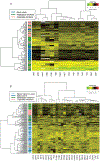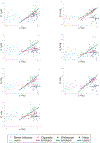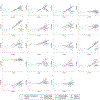Urinary Biomarkers of Carcinogenic Exposure among Cigarette, Waterpipe, and Smokeless Tobacco Users and Never Users of Tobacco in the Golestan Cohort Study
- PMID: 30622099
- PMCID: PMC6935158
- DOI: 10.1158/1055-9965.EPI-18-0743
Urinary Biomarkers of Carcinogenic Exposure among Cigarette, Waterpipe, and Smokeless Tobacco Users and Never Users of Tobacco in the Golestan Cohort Study
Abstract
Background: How carcinogen exposure varies across users of different, particularly noncigarette, tobacco products remains poorly understood.
Methods: We randomly selected 165 participants of the Golestan Cohort Study from northeastern Iran: 60 never users of any tobacco, 35 exclusive cigarette, 40 exclusive (78% daily) waterpipe, and 30 exclusive smokeless tobacco (nass) users. We measured concentrations of 39 biomarkers of exposure in 4 chemical classes in baseline urine samples: tobacco alkaloids, tobacco-specific nitrosamines (TSNA), polycyclic aromatic hydrocarbons (PAH), and volatile organic compounds (VOC). We also quantified the same biomarkers in a second urine sample, obtained 5 years later, among continuing cigarette smokers and never tobacco users.
Results: Nass users had the highest concentrations of tobacco alkaloids. All tobacco users had elevated TSNA concentrations, which correlated with nicotine dose. In both cigarette and waterpipe smokers, PAH and VOC biomarkers were higher than never tobacco users and nass users, and highly correlated with nicotine dose. PAH biomarkers of phenanthrene and pyrene and two VOC metabolites (phenylmercapturic acid and phenylglyoxylic acid) were higher in waterpipe smokers than in all other groups. PAH biomarkers among Golestan never tobacco users were comparable to those in U.S. cigarette smokers. All biomarkers had moderate to good correlations over 5 years, particularly in continuing cigarette smokers.
Conclusions: We observed two patterns of exposure biomarkers that differentiated the use of the combustible products (cigarettes and waterpipe) from the smokeless product. Environmental exposure from nontobacco sources appeared to contribute to the presence of high levels of PAH metabolites in the Golestan Cohort.
Impact: Most of these biomarkers would be useful for exposure assessment in a longitudinal study.
©2019 American Association for Cancer Research.
Figures



Similar articles
-
Biomarkers of Exposure among Adult Smokeless Tobacco Users in the Population Assessment of Tobacco and Health Study (Wave 1, 2013-2014).Cancer Epidemiol Biomarkers Prev. 2020 Mar;29(3):659-667. doi: 10.1158/1055-9965.EPI-19-0766. Epub 2020 Jan 27. Cancer Epidemiol Biomarkers Prev. 2020. PMID: 31988072 Free PMC article.
-
Comparison of Urinary Biomarkers of Exposure in Humans Using Electronic Cigarettes, Combustible Cigarettes, and Smokeless Tobacco.Nicotine Tob Res. 2019 Aug 19;21(9):1228-1238. doi: 10.1093/ntr/nty089. Nicotine Tob Res. 2019. PMID: 29868926 Free PMC article.
-
Opiate and Tobacco Use and Exposure to Carcinogens and Toxicants in the Golestan Cohort Study.Cancer Epidemiol Biomarkers Prev. 2020 Mar;29(3):650-658. doi: 10.1158/1055-9965.EPI-19-1212. Epub 2020 Jan 8. Cancer Epidemiol Biomarkers Prev. 2020. PMID: 31915141 Free PMC article.
-
Tobacco-specific N-nitrosamines and Areca-derived N-nitrosamines: chemistry, biochemistry, carcinogenicity, and relevance to humans.J Toxicol Environ Health. 1994 Jan;41(1):1-52. doi: 10.1080/15287399409531825. J Toxicol Environ Health. 1994. PMID: 8277523 Review.
-
Smokeless tobacco and cigarette smoking: chemical mechanisms and cancer prevention.Nat Rev Cancer. 2022 Mar;22(3):143-155. doi: 10.1038/s41568-021-00423-4. Epub 2022 Jan 3. Nat Rev Cancer. 2022. PMID: 34980891 Free PMC article. Review.
Cited by
-
Human Exposure Levels of Volatile Organic Compounds in E-waste Recycling Area: Get Insight into Impacts of Manipulation Mode and Associations with Oxidative Stress Markers.Environ Health (Wash). 2023 Nov 8;1(6):405-415. doi: 10.1021/envhealth.3c00131. eCollection 2023 Dec 15. Environ Health (Wash). 2023. PMID: 39474053 Free PMC article.
-
Volatile organic compounds and mortality from ischemic heart disease: A case-cohort study.Am J Prev Cardiol. 2024 Jun 23;19:100700. doi: 10.1016/j.ajpc.2024.100700. eCollection 2024 Sep. Am J Prev Cardiol. 2024. PMID: 39100747 Free PMC article.
-
Prevalence and Incidence of Metabolic Syndrome and Its Components Among Waterpipe Users.Int J Public Health. 2024 Jul 11;69:1607156. doi: 10.3389/ijph.2024.1607156. eCollection 2024. Int J Public Health. 2024. PMID: 39056061 Free PMC article.
-
Toxicity of waterpipe tobacco smoking: the role of flavors, sweeteners, humectants, and charcoal.Toxicol Sci. 2024 Oct 1;201(2):159-173. doi: 10.1093/toxsci/kfae095. Toxicol Sci. 2024. PMID: 39037923 Free PMC article. Review.
-
Dental health and lung cancer risk in the Golestan Cohort Study.BMC Cancer. 2024 Jan 13;24(1):74. doi: 10.1186/s12885-024-11850-5. BMC Cancer. 2024. PMID: 38218793 Free PMC article.
References
-
- Bilano V, Gilmour S, Moffiet T, d’Espaignet ET, Stevens GA, Commar A, et al. Global trends and projections for tobacco use, 1990–2025: an analysis of smoking indicators from the WHO Comprehensive Information Systems for Tobacco Control. Lancet 2015;385(9972):966–76 doi 10.1016/S0140-6736(15)60264-1. - DOI - PubMed
-
- Eriksen MP, Mackay J, Schluger NW, Islami F, Drope J. The tobacco atlas. Atlanta, Georgia, 30303, USA: Published by the American Cancer Society,; 2015.
Publication types
MeSH terms
Substances
Grants and funding
LinkOut - more resources
Full Text Sources


